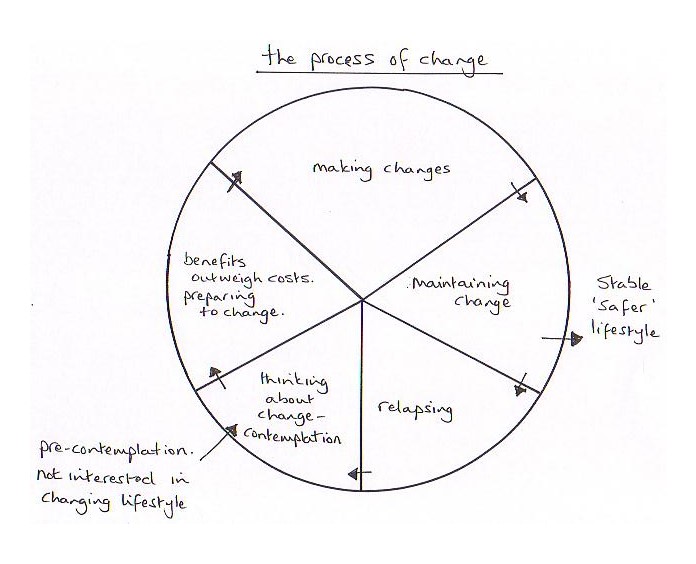How To Make Changes In Your Life
12th Nov 2019
Do you sometimes get stuck in a rut,
or feel awful about someone or something, get the urge to change, have a go, make a little progress, then flop back into the same old routine or rut? There are reasons you do this, and, take heart, there are ways to stop doing this and make positive steps towards changing.
There is a structure to changing, and understanding the structure, then giving it a go, can really help you to succeed in changing anything you want to.
The structure is called the 'Model of Change'. It was developed by Prochaska and DiClemente in 1986. It's easy to understand, very effective, and well worth having a go with whatever you want to change. It's also comforting and motivating having a constructive support along the way. It helps you to realise that change is really possible, often fairly easy, and certainly achievable.
Study this diagram for a while and see if you can make sense of it (and read my writing).
Let's take an issue you want to change, and go through the different steps
that make up the Process of Change structure.
Example Problem:
I want to change to a healthier diet, but with my work load, I don't even have time to eat.
OK. I'm going to apply the process of change to this problem.
Not interested in change (bottom left of diagram)
There are three possibilities to make you feel not interested in change:
- You may have thought about change, but decided against it.
- Or you are not aware that change may be needed.
- Or you don't know how to change.
Nº.3 I don't know how to change, so I usually leave things as they are.
Thinking about change / contemplation
Something may have triggered the thought of change, such as personal loss, illness, or feeling unable to cope. You could spend a lot of time in this stage.
I need to find a way to change, because I don't feel healthy and I keep getting ill.
Preparing to change / the practicalities and costs
Here you consider the practicalities, costs and benefits of change. You continue if you feel that the benefits outweigh the costs. We're not talking about financial costs here, but about time, effort and other considerations.
How much time and effort will it take to plan a better diet, prepare it all, and get to eat it, without my work suffering? I'll make some lists and do a bit of time management.
Making changes
This is the planning stage where you consider possible difficulties, gather information, set realistic goals and, if you feel it necessary, enlist support.
I'm going to make a list of healthy foods that are easy to prepare and take to work with me. I need to buy the stuff, organise my kitchen, get some containers and a cute cool bag to put my healthy food in. I can prepare it all the night before and get up a little earlier to transfer it from the fridge into my bags. I can prepare smoothie ingredients the night before, and blend them in a minute in the morning, and that's my healthy breakfast on the way to work.
Maintaining change
It can be hard to keep up the change, but it is important to keep focusing on the benefits and rely on your support.
I'm feeling healthier, so I want to keep this up. I need to find other foods, so that it doesn't get boring eating the same foods day after day. I'll get some ideas from the internet.
Stable Lifestyle
The change is no longer difficult to maintain. It has become your normal state of being.
This is now part of my life and routine. I have more energy and motivation to continue, as I've lost weight, my skin has cleared up, and I feel great.
Relapsing
This is when you revert to your original mind-set (ie. negative thinking). You need to examine your reason.
- Were my goals unrealistic?
- Was the change really to please someone else?
- Has my life situation changed again, so I need a different solution?
This stage can last a short time or a long time.
I let it go for a couple of weeks and am back to feeling horrible, with no energy. I became disorganised, as I ran out of food and had no time to buy more.
It is important not to get despondent. Change can be considered again, when the time is right for you, and you really want it.
I do want to change, permanently. I just need to get a bit more organised with my food shopping twice a week, not once every two weeks. I'm not going to beat myself up, because I know I can do it! I'll simply start again.
Motivating
It can be motivating and encouraging to see an idea presented in a constructive manner like this. It will help you to stop becoming overwhelmed when trying to change, or dispirited when you slip back from positive to negative. It will also motivate you to keep trying.
The more you try to change from negative to positive thinking, the more your brain picks up on this, and the flow of feel-good hormones through your body will begin to increase, while the flow of stress chemicals will decrease. Every little bit helps in your overall health and well-being and ultimately your life situation.
Let me know how you get on.
Copyright © 2019 Brenda Martin





